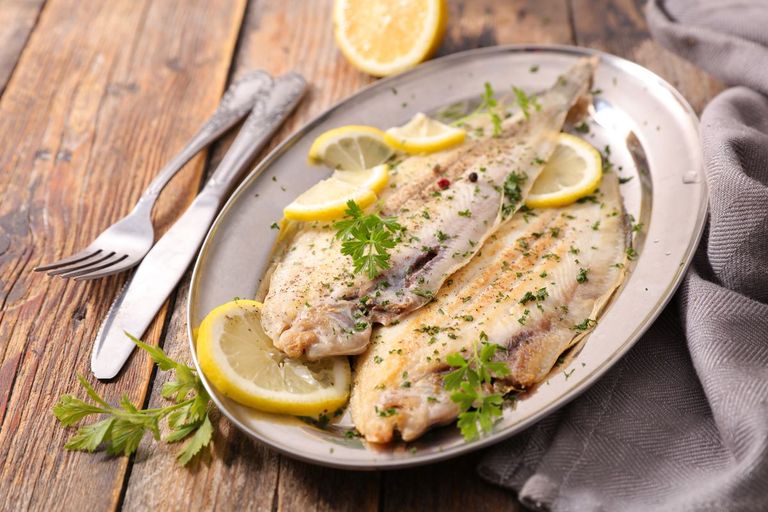
Una receta que, además de excelente y ligera, puedes hacer con los ojos cerrados. Para preparar el plato también puedes utilizar filetes de lenguado.

A recipe that, in addition to being excellent and light, you can make with your eyes closed. To prepare the dish you can also use sole fillets.
Características y propiedades nutritivas del lenguado. / Characteristics and nutritional properties of sole
La especie de lenguado más extendida es Solea Solea, también llamada "lenguado común". Se pesca durante todo el año, pero especialmente en los meses de invierno y está muy extendido por todo el Mediterráneo, pero también en el Mar del Norte y el Mar Negro.
Una característica distintiva es el hecho de que vive en el fondo marino, mientras que la forma plana y elipsoidal, marrón en el lado derecho y blanco en el izquierdo, permite distinguir fácilmente el lenguado de la solla y el fletán que, en cambio, tienen forma romboidal.
El lenguado es un pescado magro y bajo en grasas; se presta a dietas de adelgazamiento hipocalóricas y, puesto que aporta cantidades modestas de colesterol y presenta un claro predominio de ácidos grasos insaturados sobre los saturados, se utiliza frecuentemente en la estructuración de dietas contra la hipercolesterolemia y la hipertrigliceridemia. Las buenas concentraciones de ácidos grasos esenciales del grupo ω3 (no visibles en la tabla) también son útiles en la lucha contra la hipertensión.
Se pueden observar pequeñas trazas de carbohidratos simples pero el macronutriente dominante es sin duda el peptídico. Además, las proteínas son de alto valor biológico, tienen el triptófano como aminoácido "limitante" (presente en menores cantidades) y son abundantes en ácido glutámico, ácido aspártico y lisina.
Entre las sales minerales, las más presentes son el potasio y el fósforo, mientras que en cuanto a las vitaminas es apreciable el contenido de niacina o vit.

The most widespread species of sole is Solea Solea, also called "common sole". It is fished throughout the year, but especially in the winter months and is widespread throughout the Mediterranean, but also in the North Sea and the Black Sea.
A distinctive feature is the fact that it lives on the seabed, while the flat, ellipsoidal shape, brown on the right side and white on the left, makes it easy to distinguish sole from plaice and halibut, which, on the other hand, have rhomboidal shape.
Sole is a lean, low-fat fish; It lends itself to low-calorie weight loss diets and, since it provides modest amounts of cholesterol and has a clear predominance of unsaturated fatty acids over saturated ones, it is frequently used in structuring diets against hypercholesterolemia and hypertriglyceridemia. Good concentrations of essential fatty acids of the ω3 group (not visible in the table) are also useful in the fight against hypertension.
Small traces of simple carbohydrates can be observed but the dominant macronutrient is undoubtedly the peptide. In addition, proteins are of high biological value, have tryptophan as a "limiting" amino acid (present in smaller quantities) and are abundant in glutamic acid, aspartic acid and lysine.
Among the mineral salts, the most present are potassium and phosphorus, while as for vitamins, the content of niacin or vit is notable.
Receta para personas n. 4 / Recipe for people no. 4

- 4 lenguados
- 100 g de mantequilla
- 3 cucharadas de aceite de oliva virgen extra
- una cucharada de leche
- un vaso de vino blanco seco
- la yema de un huevo
- sal
- pimienta

- 4 soles
- 100g butter
- 3 tablespoons extra virgin olive oil
- a tablespoon of milk
- A glass of dry white wine
- the yolk of an egg
- salt
- pepper

30'
- Se deben disponer los lenguados, sin superponerlos, en una bandeja de horno y verter sobre ellos el aceite, la sal, la pimienta y el vino blanco.
- A continuación, se debe mantener la sartén en el horno durante veinte minutos a una temperatura de 180 grados y en cualquier caso hasta que el pescado esté cocido.
- Una vez cocido, se debe colocar el pescado en una fuente para servir y mantenerlo caliente mientras se recoge la salsa que queda en la sartén y se coloca en una sartén y se cocina al fuego hasta que se reduzca a la mitad.
- Mientras tanto se ha mezclado la yema de huevo y la leche, que luego se verterá y se mezclará con la salsa.
- Continúe cocinando agregando mantequilla.
- Cuando la salsa esté espesa estará lista para verterla sobre el pescado y servirla en la mesa.

- Arrange the soles, without overlapping them, on a baking tray and pour the oil, salt, pepper and white wine over them.
- Next, you should keep the pan in the oven for twenty minutes at a temperature of 180 degrees and in any case until the fish is cooked.
- Once cooked, the fish should be placed on a serving platter and kept warm while the sauce remaining in the pan is collected and placed in a frying pan and cooked over the heat until it is reduced by half.
- Meanwhile, the egg yolk and milk have been mixed, which will then be poured and mixed with the sauce.
- Continue cooking adding butter.
- When the sauce is thick it is ready to pour over the fish and serve at the table
El pescado y sus propiedades. / Fish and its properties.
Entre los pescados comunes, los más selectos son: esturión, pargo, corvina, araña, lenguado, rodaballo, pez de San Pedro, besugo, salmonete, trucha de agua dulce; excelente durante todo el año, pero lenguado y rodaballo especialmente en invierno.
Las temporadas de los otros pescados más conocidos son: la merluza, la anguila y el calamar, todo el año; pero la anguila es más adecuada para el invierno y los calamares son mejores para el verano.
Para salmonetes, julio y agosto; para el salmonete (mújol), octubre y noviembre, y también todo el invierno. Para gobios, alevines y sepias, marzo, abril y mayo. Para los pulpos, octubre. Para sardinas y anchoas, todo el invierno hasta abril. Para salmonetes (púas), septiembre y octubre. Para el bonito, de marzo a octubre.
El pescado, si es fresco, tiene un ojo vivaz y brillante; lo pone pálido y deslustrado si no está fresco. Otro indicio de su frescura es el color rojo de las branquias; pero es posible que hayan sido coloreados artísticamente con sangre, tócalos con un dedo y acércatelo a la nariz: el olor te lo dirá. Otra característica del pescado fresco es la firmeza de la carne, pues si permanece mucho tiempo en hielo se vuelve dura y suave al tacto.

Among the common fish, the most select are: sturgeon, snapper, croaker, spider, sole, turbot, St. Peter's fish, bream, mullet, freshwater trout; excellent all year round, but sole and turbot especially in winter.
The seasons of the other best-known fish are: hake, eel and squid, all year round; but eel is more suitable for winter and squid is better for summer.
For mullet, July and August; for mullet (mullet), October and November, and also all winter. For gobies, fry and cuttlefish, March, April and May. For octopuses, October. For sardines and anchovies, all winter until April. For mullet (barbs), September and October. For the bonito, from March to October.
The fish, if it is fresh, has a lively and bright eye; it makes it pale and dull if it is not fresh. Another indication of its freshness is the red color of the gills; but they may have been artistically colored with blood, touch them with a finger and bring it to your nose: the smell will tell you. Another characteristic of fresh fish is the firmness of the meat, because if it remains in ice for a long time it becomes hard and soft to the touch.

Fuente imagen inicial . / Source initial image: Gusto.blog

Fuente imagen final. / Source final image: Unsplash by Gregor Moser.
Estas recetas y tantas otras publicadas en #BLURT las pueden encontrar en mis blogs en italiano, inglés y español. Más de 5.000 recetas para darle fantasía y color a tu mesa y hacer una figura digna de un/a chefs con tus invitados.
These recipes and many others published in # BLURT can be found on my blogs in Italian, English and Spanish. More than 5,000 recipes to give fantasy and color to your table and make a figure worthy of a chef with your guests.
Y como siempre me despido de todos con un:
And as always I bid you all farewell with a:

Upvoted. Thank You for sending some of your rewards to @null. Read my last posts to make sure that BLURT burning is profitable for you. Before using this bot please make sure your account has at least 100 BP. Get more BLURT:
@ mariuszkarowski/how-to-get-automatic-upvote-from-my-accounts@ blurtbooster/blurt-booster-introduction-rules-and-guidelines-1699999662965@ nalexadre/blurt-nexus-creating-an-affiliate-account-1700008765859@ kryptodenno - win BLURT POWER delegationNote: This bot will not vote on AI-generated content
Thanks @ctime!